Advanced Nurse Practitioner Role: Critical Analysis & Application
VerifiedAdded on 2023/05/29
|13
|3886
|370
Essay
AI Summary
This essay critically analyzes the role of the Advanced Nurse Practitioner (ANP), exploring its origin, responsibilities, and standards of practice, particularly within the Australian healthcare context. It discusses the evolution of the ANP role in response to healthcare challenges such as an aging population and increasing demand for specialized care. The essay examines the ANP's diverse responsibilities, including patient education, disease management, and ethical decision-making, while also highlighting the importance of collaboration within multidisciplinary teams. Furthermore, it delves into the practice standards set by the Nursing and Midwifery Board of Australia (NMBA) and the Australian Health Practitioner Regulation Agency (AHPRA), emphasizing the ANP's role in clinical governance and advanced clinical decision-making. Finally, the essay explores the potential application and benefits of implementing the ANP role in an aged care setting, based on research highlighting improved patient satisfaction and therapeutic alliances.
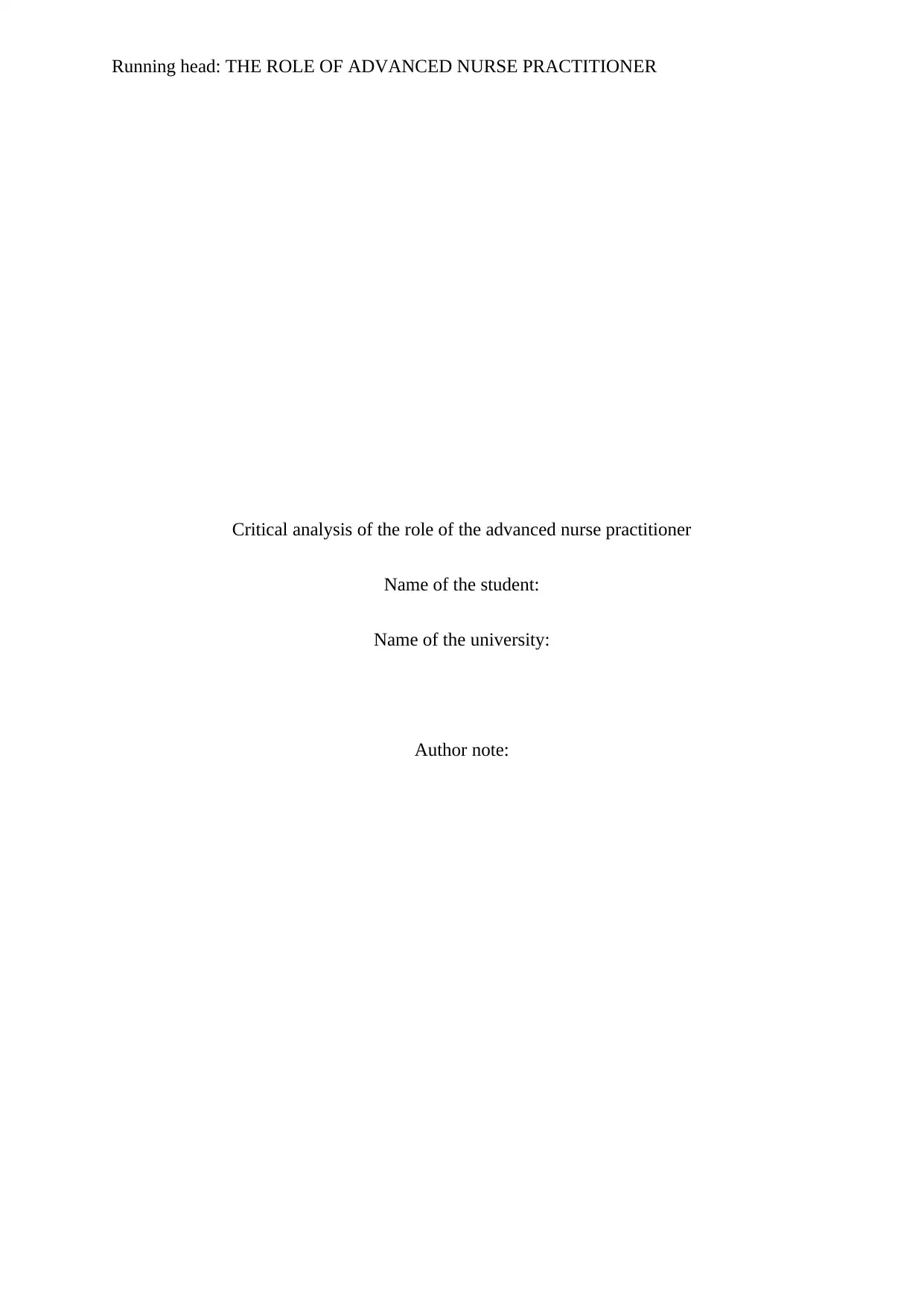
Running head: THE ROLE OF ADVANCED NURSE PRACTITIONER
Critical analysis of the role of the advanced nurse practitioner
Name of the student:
Name of the university:
Author note:
Critical analysis of the role of the advanced nurse practitioner
Name of the student:
Name of the university:
Author note:
Paraphrase This Document
Need a fresh take? Get an instant paraphrase of this document with our AI Paraphraser

1
THE ROLE OF ADVANCED NURSE PRACTITIONER
Introduction:
The roles and responsibilities of a nursing professional is diverse and it encompasses
an array of activities ranging from assessing the care needs of the patents to advocating for
their best interests. Carney (2016)have described the nurses to be only health care
professionals that have the opportunity and accountability to develop strong therapeutic
alliances with the patients and their family members as well. Hence, the patients also spend
the most of their time with the nurses developing a comfort level that allows them to open up
to the nurses regarding their issues and grievances that they are suffering from. Hence, the
nurses have a fundamental role in the health care scenario and they are central to the delivery
of optimal patient centred care to the patient population.
However, the roles and responsibilities a nurse often overlaps and that is why there
are various specific designation guiding the nurses through better understanding of the exact
roles and responsibilities they are to be addressing while in practice (McDonnell et al., 2015).
The advanced nurse practitioner is a job role that has evolved in the recent years
encompassing more specific, detailed and critical nursing responsibilities and patient care
requirements. This essay will attempt to explore the roles and responsibilities of an advanced
nurse practitioner (ANP) and critically analyse the literature, ultimately applying the data
gathered to explore the effectiveness of the role of an ANP in our hospital setting.
Discussion:
Advanced nurse practitioner, the origin of the designation and the description of the roles:
THE ROLE OF ADVANCED NURSE PRACTITIONER
Introduction:
The roles and responsibilities of a nursing professional is diverse and it encompasses
an array of activities ranging from assessing the care needs of the patents to advocating for
their best interests. Carney (2016)have described the nurses to be only health care
professionals that have the opportunity and accountability to develop strong therapeutic
alliances with the patients and their family members as well. Hence, the patients also spend
the most of their time with the nurses developing a comfort level that allows them to open up
to the nurses regarding their issues and grievances that they are suffering from. Hence, the
nurses have a fundamental role in the health care scenario and they are central to the delivery
of optimal patient centred care to the patient population.
However, the roles and responsibilities a nurse often overlaps and that is why there
are various specific designation guiding the nurses through better understanding of the exact
roles and responsibilities they are to be addressing while in practice (McDonnell et al., 2015).
The advanced nurse practitioner is a job role that has evolved in the recent years
encompassing more specific, detailed and critical nursing responsibilities and patient care
requirements. This essay will attempt to explore the roles and responsibilities of an advanced
nurse practitioner (ANP) and critically analyse the literature, ultimately applying the data
gathered to explore the effectiveness of the role of an ANP in our hospital setting.
Discussion:
Advanced nurse practitioner, the origin of the designation and the description of the roles:
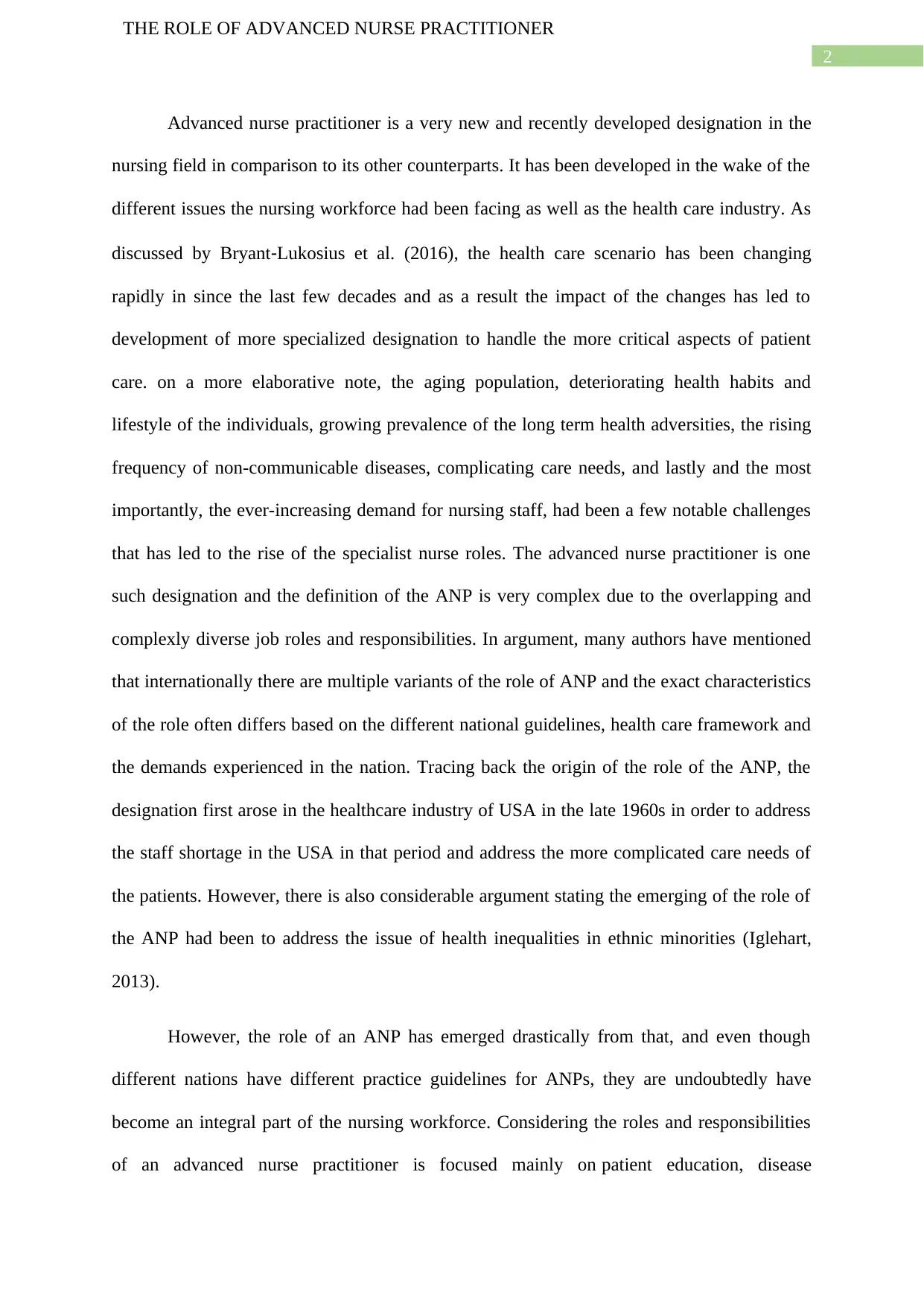
2
THE ROLE OF ADVANCED NURSE PRACTITIONER
Advanced nurse practitioner is a very new and recently developed designation in the
nursing field in comparison to its other counterparts. It has been developed in the wake of the
different issues the nursing workforce had been facing as well as the health care industry. As
discussed by Bryant‐Lukosius et al. (2016), the health care scenario has been changing
rapidly in since the last few decades and as a result the impact of the changes has led to
development of more specialized designation to handle the more critical aspects of patient
care. on a more elaborative note, the aging population, deteriorating health habits and
lifestyle of the individuals, growing prevalence of the long term health adversities, the rising
frequency of non-communicable diseases, complicating care needs, and lastly and the most
importantly, the ever-increasing demand for nursing staff, had been a few notable challenges
that has led to the rise of the specialist nurse roles. The advanced nurse practitioner is one
such designation and the definition of the ANP is very complex due to the overlapping and
complexly diverse job roles and responsibilities. In argument, many authors have mentioned
that internationally there are multiple variants of the role of ANP and the exact characteristics
of the role often differs based on the different national guidelines, health care framework and
the demands experienced in the nation. Tracing back the origin of the role of the ANP, the
designation first arose in the healthcare industry of USA in the late 1960s in order to address
the staff shortage in the USA in that period and address the more complicated care needs of
the patients. However, there is also considerable argument stating the emerging of the role of
the ANP had been to address the issue of health inequalities in ethnic minorities (Iglehart,
2013).
However, the role of an ANP has emerged drastically from that, and even though
different nations have different practice guidelines for ANPs, they are undoubtedly have
become an integral part of the nursing workforce. Considering the roles and responsibilities
of an advanced nurse practitioner is focused mainly on patient education, disease
THE ROLE OF ADVANCED NURSE PRACTITIONER
Advanced nurse practitioner is a very new and recently developed designation in the
nursing field in comparison to its other counterparts. It has been developed in the wake of the
different issues the nursing workforce had been facing as well as the health care industry. As
discussed by Bryant‐Lukosius et al. (2016), the health care scenario has been changing
rapidly in since the last few decades and as a result the impact of the changes has led to
development of more specialized designation to handle the more critical aspects of patient
care. on a more elaborative note, the aging population, deteriorating health habits and
lifestyle of the individuals, growing prevalence of the long term health adversities, the rising
frequency of non-communicable diseases, complicating care needs, and lastly and the most
importantly, the ever-increasing demand for nursing staff, had been a few notable challenges
that has led to the rise of the specialist nurse roles. The advanced nurse practitioner is one
such designation and the definition of the ANP is very complex due to the overlapping and
complexly diverse job roles and responsibilities. In argument, many authors have mentioned
that internationally there are multiple variants of the role of ANP and the exact characteristics
of the role often differs based on the different national guidelines, health care framework and
the demands experienced in the nation. Tracing back the origin of the role of the ANP, the
designation first arose in the healthcare industry of USA in the late 1960s in order to address
the staff shortage in the USA in that period and address the more complicated care needs of
the patients. However, there is also considerable argument stating the emerging of the role of
the ANP had been to address the issue of health inequalities in ethnic minorities (Iglehart,
2013).
However, the role of an ANP has emerged drastically from that, and even though
different nations have different practice guidelines for ANPs, they are undoubtedly have
become an integral part of the nursing workforce. Considering the roles and responsibilities
of an advanced nurse practitioner is focused mainly on patient education, disease
⊘ This is a preview!⊘
Do you want full access?
Subscribe today to unlock all pages.

Trusted by 1+ million students worldwide
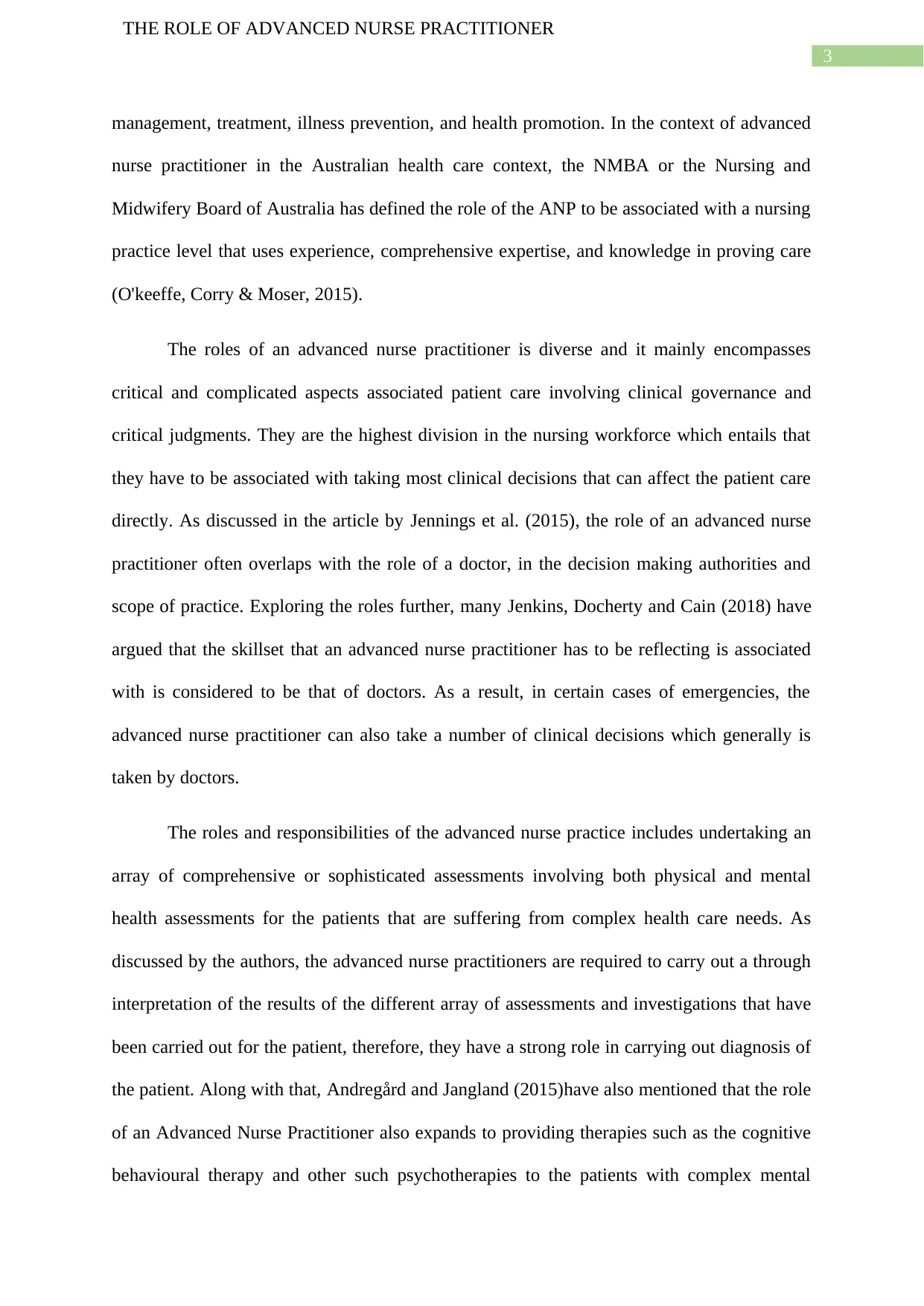
3
THE ROLE OF ADVANCED NURSE PRACTITIONER
management, treatment, illness prevention, and health promotion. In the context of advanced
nurse practitioner in the Australian health care context, the NMBA or the Nursing and
Midwifery Board of Australia has defined the role of the ANP to be associated with a nursing
practice level that uses experience, comprehensive expertise, and knowledge in proving care
(O'keeffe, Corry & Moser, 2015).
The roles of an advanced nurse practitioner is diverse and it mainly encompasses
critical and complicated aspects associated patient care involving clinical governance and
critical judgments. They are the highest division in the nursing workforce which entails that
they have to be associated with taking most clinical decisions that can affect the patient care
directly. As discussed in the article by Jennings et al. (2015), the role of an advanced nurse
practitioner often overlaps with the role of a doctor, in the decision making authorities and
scope of practice. Exploring the roles further, many Jenkins, Docherty and Cain (2018) have
argued that the skillset that an advanced nurse practitioner has to be reflecting is associated
with is considered to be that of doctors. As a result, in certain cases of emergencies, the
advanced nurse practitioner can also take a number of clinical decisions which generally is
taken by doctors.
The roles and responsibilities of the advanced nurse practice includes undertaking an
array of comprehensive or sophisticated assessments involving both physical and mental
health assessments for the patients that are suffering from complex health care needs. As
discussed by the authors, the advanced nurse practitioners are required to carry out a through
interpretation of the results of the different array of assessments and investigations that have
been carried out for the patient, therefore, they have a strong role in carrying out diagnosis of
the patient. Along with that, Andregård and Jangland (2015)have also mentioned that the role
of an Advanced Nurse Practitioner also expands to providing therapies such as the cognitive
behavioural therapy and other such psychotherapies to the patients with complex mental
THE ROLE OF ADVANCED NURSE PRACTITIONER
management, treatment, illness prevention, and health promotion. In the context of advanced
nurse practitioner in the Australian health care context, the NMBA or the Nursing and
Midwifery Board of Australia has defined the role of the ANP to be associated with a nursing
practice level that uses experience, comprehensive expertise, and knowledge in proving care
(O'keeffe, Corry & Moser, 2015).
The roles of an advanced nurse practitioner is diverse and it mainly encompasses
critical and complicated aspects associated patient care involving clinical governance and
critical judgments. They are the highest division in the nursing workforce which entails that
they have to be associated with taking most clinical decisions that can affect the patient care
directly. As discussed in the article by Jennings et al. (2015), the role of an advanced nurse
practitioner often overlaps with the role of a doctor, in the decision making authorities and
scope of practice. Exploring the roles further, many Jenkins, Docherty and Cain (2018) have
argued that the skillset that an advanced nurse practitioner has to be reflecting is associated
with is considered to be that of doctors. As a result, in certain cases of emergencies, the
advanced nurse practitioner can also take a number of clinical decisions which generally is
taken by doctors.
The roles and responsibilities of the advanced nurse practice includes undertaking an
array of comprehensive or sophisticated assessments involving both physical and mental
health assessments for the patients that are suffering from complex health care needs. As
discussed by the authors, the advanced nurse practitioners are required to carry out a through
interpretation of the results of the different array of assessments and investigations that have
been carried out for the patient, therefore, they have a strong role in carrying out diagnosis of
the patient. Along with that, Andregård and Jangland (2015)have also mentioned that the role
of an Advanced Nurse Practitioner also expands to providing therapies such as the cognitive
behavioural therapy and other such psychotherapies to the patients with complex mental
Paraphrase This Document
Need a fresh take? Get an instant paraphrase of this document with our AI Paraphraser
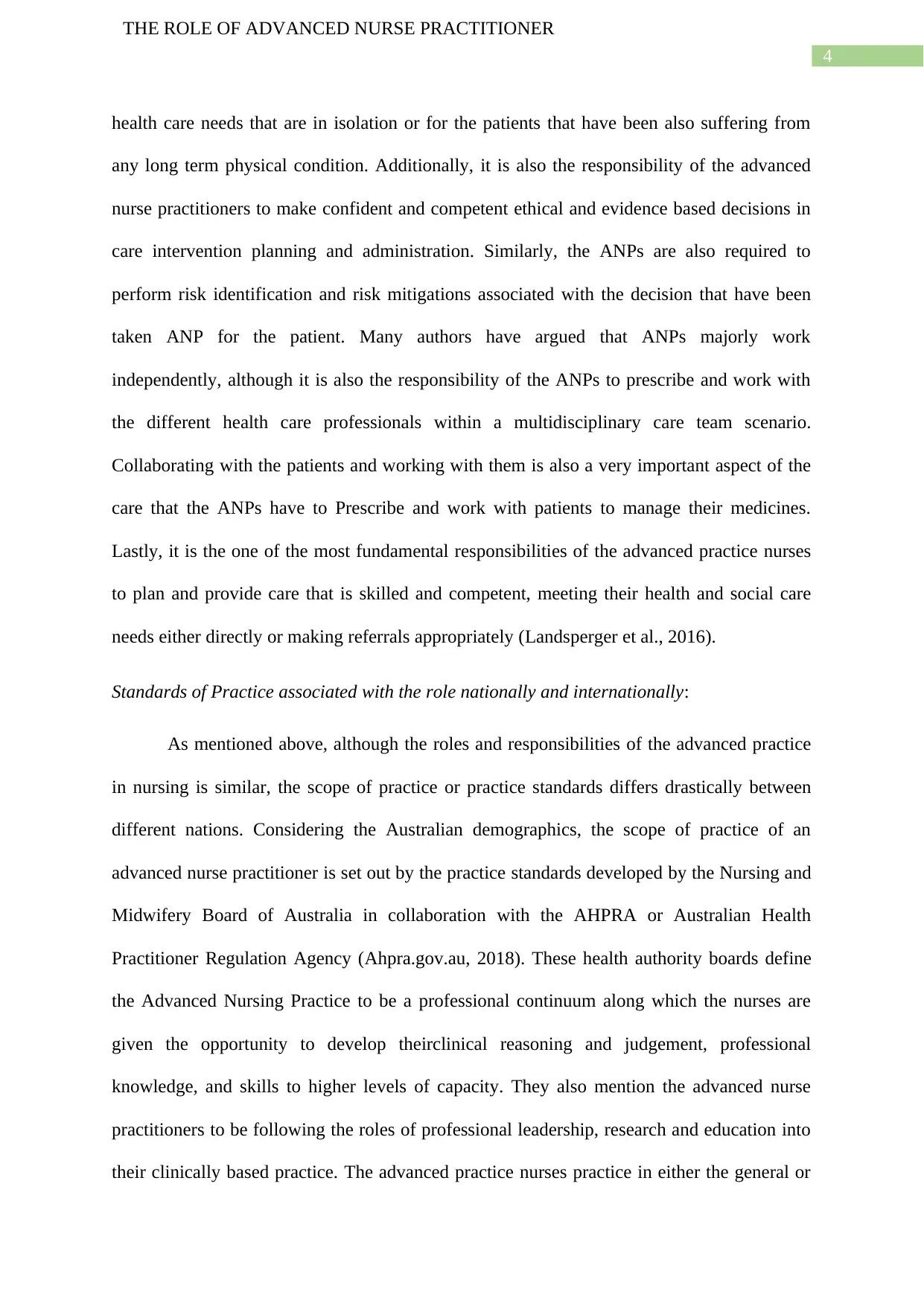
4
THE ROLE OF ADVANCED NURSE PRACTITIONER
health care needs that are in isolation or for the patients that have been also suffering from
any long term physical condition. Additionally, it is also the responsibility of the advanced
nurse practitioners to make confident and competent ethical and evidence based decisions in
care intervention planning and administration. Similarly, the ANPs are also required to
perform risk identification and risk mitigations associated with the decision that have been
taken ANP for the patient. Many authors have argued that ANPs majorly work
independently, although it is also the responsibility of the ANPs to prescribe and work with
the different health care professionals within a multidisciplinary care team scenario.
Collaborating with the patients and working with them is also a very important aspect of the
care that the ANPs have to Prescribe and work with patients to manage their medicines.
Lastly, it is the one of the most fundamental responsibilities of the advanced practice nurses
to plan and provide care that is skilled and competent, meeting their health and social care
needs either directly or making referrals appropriately (Landsperger et al., 2016).
Standards of Practice associated with the role nationally and internationally:
As mentioned above, although the roles and responsibilities of the advanced practice
in nursing is similar, the scope of practice or practice standards differs drastically between
different nations. Considering the Australian demographics, the scope of practice of an
advanced nurse practitioner is set out by the practice standards developed by the Nursing and
Midwifery Board of Australia in collaboration with the AHPRA or Australian Health
Practitioner Regulation Agency (Ahpra.gov.au, 2018). These health authority boards define
the Advanced Nursing Practice to be a professional continuum along which the nurses are
given the opportunity to develop theirclinical reasoning and judgement, professional
knowledge, and skills to higher levels of capacity. They also mention the advanced nurse
practitioners to be following the roles of professional leadership, research and education into
their clinically based practice. The advanced practice nurses practice in either the general or
THE ROLE OF ADVANCED NURSE PRACTITIONER
health care needs that are in isolation or for the patients that have been also suffering from
any long term physical condition. Additionally, it is also the responsibility of the advanced
nurse practitioners to make confident and competent ethical and evidence based decisions in
care intervention planning and administration. Similarly, the ANPs are also required to
perform risk identification and risk mitigations associated with the decision that have been
taken ANP for the patient. Many authors have argued that ANPs majorly work
independently, although it is also the responsibility of the ANPs to prescribe and work with
the different health care professionals within a multidisciplinary care team scenario.
Collaborating with the patients and working with them is also a very important aspect of the
care that the ANPs have to Prescribe and work with patients to manage their medicines.
Lastly, it is the one of the most fundamental responsibilities of the advanced practice nurses
to plan and provide care that is skilled and competent, meeting their health and social care
needs either directly or making referrals appropriately (Landsperger et al., 2016).
Standards of Practice associated with the role nationally and internationally:
As mentioned above, although the roles and responsibilities of the advanced practice
in nursing is similar, the scope of practice or practice standards differs drastically between
different nations. Considering the Australian demographics, the scope of practice of an
advanced nurse practitioner is set out by the practice standards developed by the Nursing and
Midwifery Board of Australia in collaboration with the AHPRA or Australian Health
Practitioner Regulation Agency (Ahpra.gov.au, 2018). These health authority boards define
the Advanced Nursing Practice to be a professional continuum along which the nurses are
given the opportunity to develop theirclinical reasoning and judgement, professional
knowledge, and skills to higher levels of capacity. They also mention the advanced nurse
practitioners to be following the roles of professional leadership, research and education into
their clinically based practice. The advanced practice nurses practice in either the general or
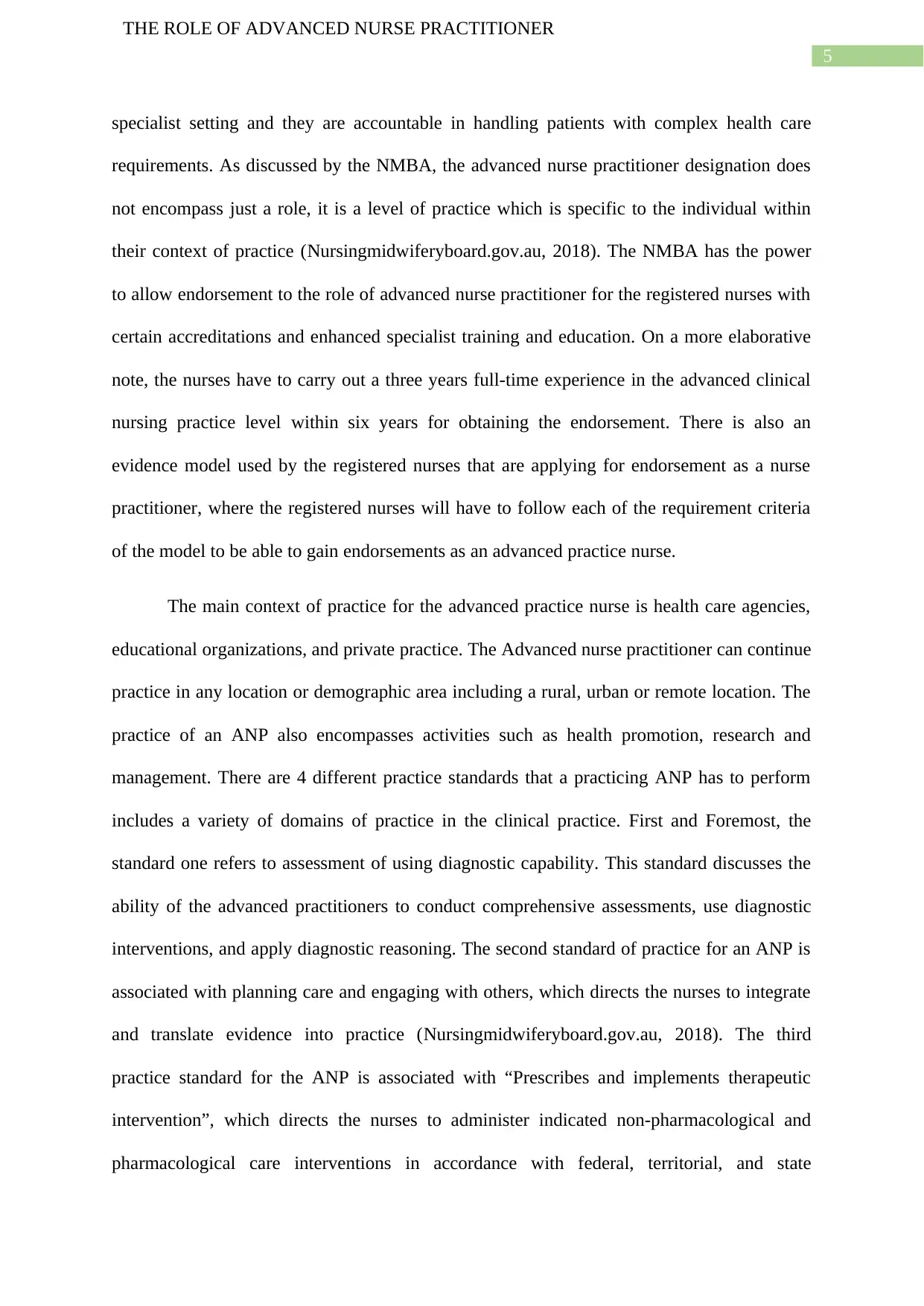
5
THE ROLE OF ADVANCED NURSE PRACTITIONER
specialist setting and they are accountable in handling patients with complex health care
requirements. As discussed by the NMBA, the advanced nurse practitioner designation does
not encompass just a role, it is a level of practice which is specific to the individual within
their context of practice (Nursingmidwiferyboard.gov.au, 2018). The NMBA has the power
to allow endorsement to the role of advanced nurse practitioner for the registered nurses with
certain accreditations and enhanced specialist training and education. On a more elaborative
note, the nurses have to carry out a three years full-time experience in the advanced clinical
nursing practice level within six years for obtaining the endorsement. There is also an
evidence model used by the registered nurses that are applying for endorsement as a nurse
practitioner, where the registered nurses will have to follow each of the requirement criteria
of the model to be able to gain endorsements as an advanced practice nurse.
The main context of practice for the advanced practice nurse is health care agencies,
educational organizations, and private practice. The Advanced nurse practitioner can continue
practice in any location or demographic area including a rural, urban or remote location. The
practice of an ANP also encompasses activities such as health promotion, research and
management. There are 4 different practice standards that a practicing ANP has to perform
includes a variety of domains of practice in the clinical practice. First and Foremost, the
standard one refers to assessment of using diagnostic capability. This standard discusses the
ability of the advanced practitioners to conduct comprehensive assessments, use diagnostic
interventions, and apply diagnostic reasoning. The second standard of practice for an ANP is
associated with planning care and engaging with others, which directs the nurses to integrate
and translate evidence into practice (Nursingmidwiferyboard.gov.au, 2018). The third
practice standard for the ANP is associated with “Prescribes and implements therapeutic
intervention”, which directs the nurses to administer indicated non-pharmacological and
pharmacological care interventions in accordance with federal, territorial, and state
THE ROLE OF ADVANCED NURSE PRACTITIONER
specialist setting and they are accountable in handling patients with complex health care
requirements. As discussed by the NMBA, the advanced nurse practitioner designation does
not encompass just a role, it is a level of practice which is specific to the individual within
their context of practice (Nursingmidwiferyboard.gov.au, 2018). The NMBA has the power
to allow endorsement to the role of advanced nurse practitioner for the registered nurses with
certain accreditations and enhanced specialist training and education. On a more elaborative
note, the nurses have to carry out a three years full-time experience in the advanced clinical
nursing practice level within six years for obtaining the endorsement. There is also an
evidence model used by the registered nurses that are applying for endorsement as a nurse
practitioner, where the registered nurses will have to follow each of the requirement criteria
of the model to be able to gain endorsements as an advanced practice nurse.
The main context of practice for the advanced practice nurse is health care agencies,
educational organizations, and private practice. The Advanced nurse practitioner can continue
practice in any location or demographic area including a rural, urban or remote location. The
practice of an ANP also encompasses activities such as health promotion, research and
management. There are 4 different practice standards that a practicing ANP has to perform
includes a variety of domains of practice in the clinical practice. First and Foremost, the
standard one refers to assessment of using diagnostic capability. This standard discusses the
ability of the advanced practitioners to conduct comprehensive assessments, use diagnostic
interventions, and apply diagnostic reasoning. The second standard of practice for an ANP is
associated with planning care and engaging with others, which directs the nurses to integrate
and translate evidence into practice (Nursingmidwiferyboard.gov.au, 2018). The third
practice standard for the ANP is associated with “Prescribes and implements therapeutic
intervention”, which directs the nurses to administer indicated non-pharmacological and
pharmacological care interventions in accordance with federal, territorial, and state
⊘ This is a preview!⊘
Do you want full access?
Subscribe today to unlock all pages.

Trusted by 1+ million students worldwide
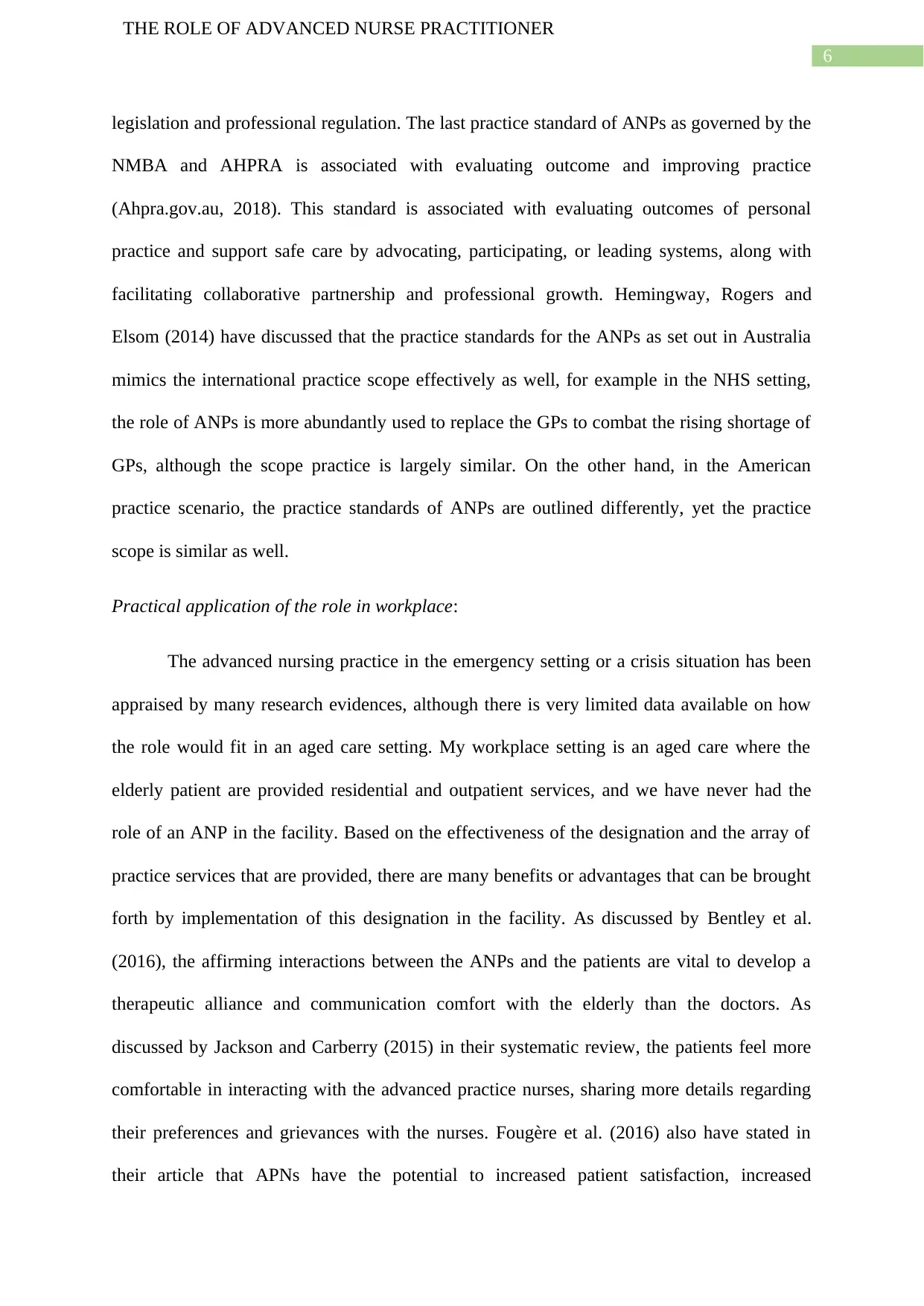
6
THE ROLE OF ADVANCED NURSE PRACTITIONER
legislation and professional regulation. The last practice standard of ANPs as governed by the
NMBA and AHPRA is associated with evaluating outcome and improving practice
(Ahpra.gov.au, 2018). This standard is associated with evaluating outcomes of personal
practice and support safe care by advocating, participating, or leading systems, along with
facilitating collaborative partnership and professional growth. Hemingway, Rogers and
Elsom (2014) have discussed that the practice standards for the ANPs as set out in Australia
mimics the international practice scope effectively as well, for example in the NHS setting,
the role of ANPs is more abundantly used to replace the GPs to combat the rising shortage of
GPs, although the scope practice is largely similar. On the other hand, in the American
practice scenario, the practice standards of ANPs are outlined differently, yet the practice
scope is similar as well.
Practical application of the role in workplace:
The advanced nursing practice in the emergency setting or a crisis situation has been
appraised by many research evidences, although there is very limited data available on how
the role would fit in an aged care setting. My workplace setting is an aged care where the
elderly patient are provided residential and outpatient services, and we have never had the
role of an ANP in the facility. Based on the effectiveness of the designation and the array of
practice services that are provided, there are many benefits or advantages that can be brought
forth by implementation of this designation in the facility. As discussed by Bentley et al.
(2016), the affirming interactions between the ANPs and the patients are vital to develop a
therapeutic alliance and communication comfort with the elderly than the doctors. As
discussed by Jackson and Carberry (2015) in their systematic review, the patients feel more
comfortable in interacting with the advanced practice nurses, sharing more details regarding
their preferences and grievances with the nurses. Fougère et al. (2016) also have stated in
their article that APNs have the potential to increased patient satisfaction, increased
THE ROLE OF ADVANCED NURSE PRACTITIONER
legislation and professional regulation. The last practice standard of ANPs as governed by the
NMBA and AHPRA is associated with evaluating outcome and improving practice
(Ahpra.gov.au, 2018). This standard is associated with evaluating outcomes of personal
practice and support safe care by advocating, participating, or leading systems, along with
facilitating collaborative partnership and professional growth. Hemingway, Rogers and
Elsom (2014) have discussed that the practice standards for the ANPs as set out in Australia
mimics the international practice scope effectively as well, for example in the NHS setting,
the role of ANPs is more abundantly used to replace the GPs to combat the rising shortage of
GPs, although the scope practice is largely similar. On the other hand, in the American
practice scenario, the practice standards of ANPs are outlined differently, yet the practice
scope is similar as well.
Practical application of the role in workplace:
The advanced nursing practice in the emergency setting or a crisis situation has been
appraised by many research evidences, although there is very limited data available on how
the role would fit in an aged care setting. My workplace setting is an aged care where the
elderly patient are provided residential and outpatient services, and we have never had the
role of an ANP in the facility. Based on the effectiveness of the designation and the array of
practice services that are provided, there are many benefits or advantages that can be brought
forth by implementation of this designation in the facility. As discussed by Bentley et al.
(2016), the affirming interactions between the ANPs and the patients are vital to develop a
therapeutic alliance and communication comfort with the elderly than the doctors. As
discussed by Jackson and Carberry (2015) in their systematic review, the patients feel more
comfortable in interacting with the advanced practice nurses, sharing more details regarding
their preferences and grievances with the nurses. Fougère et al. (2016) also have stated in
their article that APNs have the potential to increased patient satisfaction, increased
Paraphrase This Document
Need a fresh take? Get an instant paraphrase of this document with our AI Paraphraser
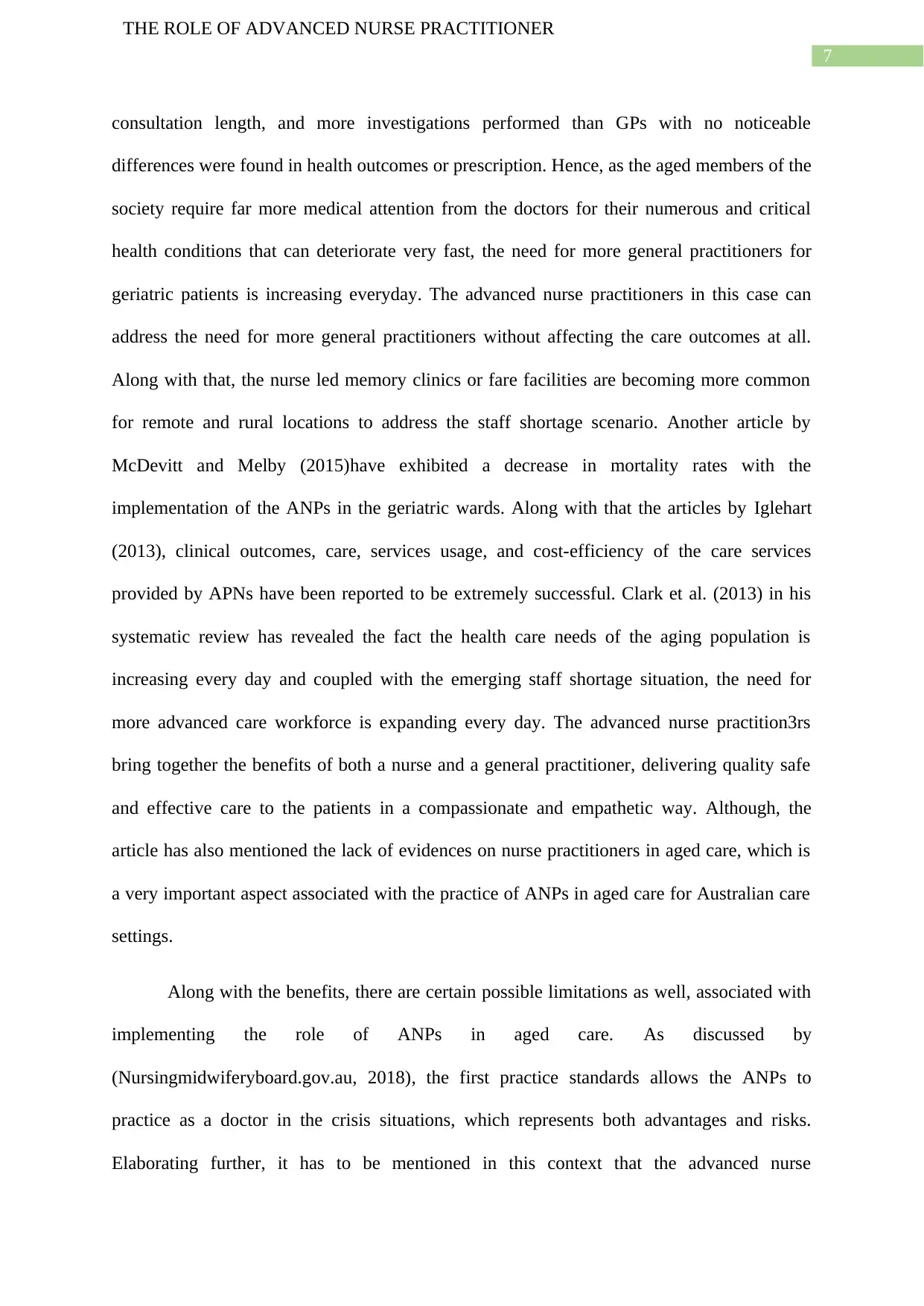
7
THE ROLE OF ADVANCED NURSE PRACTITIONER
consultation length, and more investigations performed than GPs with no noticeable
differences were found in health outcomes or prescription. Hence, as the aged members of the
society require far more medical attention from the doctors for their numerous and critical
health conditions that can deteriorate very fast, the need for more general practitioners for
geriatric patients is increasing everyday. The advanced nurse practitioners in this case can
address the need for more general practitioners without affecting the care outcomes at all.
Along with that, the nurse led memory clinics or fare facilities are becoming more common
for remote and rural locations to address the staff shortage scenario. Another article by
McDevitt and Melby (2015)have exhibited a decrease in mortality rates with the
implementation of the ANPs in the geriatric wards. Along with that the articles by Iglehart
(2013), clinical outcomes, care, services usage, and cost-efficiency of the care services
provided by APNs have been reported to be extremely successful. Clark et al. (2013) in his
systematic review has revealed the fact the health care needs of the aging population is
increasing every day and coupled with the emerging staff shortage situation, the need for
more advanced care workforce is expanding every day. The advanced nurse practition3rs
bring together the benefits of both a nurse and a general practitioner, delivering quality safe
and effective care to the patients in a compassionate and empathetic way. Although, the
article has also mentioned the lack of evidences on nurse practitioners in aged care, which is
a very important aspect associated with the practice of ANPs in aged care for Australian care
settings.
Along with the benefits, there are certain possible limitations as well, associated with
implementing the role of ANPs in aged care. As discussed by
(Nursingmidwiferyboard.gov.au, 2018), the first practice standards allows the ANPs to
practice as a doctor in the crisis situations, which represents both advantages and risks.
Elaborating further, it has to be mentioned in this context that the advanced nurse
THE ROLE OF ADVANCED NURSE PRACTITIONER
consultation length, and more investigations performed than GPs with no noticeable
differences were found in health outcomes or prescription. Hence, as the aged members of the
society require far more medical attention from the doctors for their numerous and critical
health conditions that can deteriorate very fast, the need for more general practitioners for
geriatric patients is increasing everyday. The advanced nurse practitioners in this case can
address the need for more general practitioners without affecting the care outcomes at all.
Along with that, the nurse led memory clinics or fare facilities are becoming more common
for remote and rural locations to address the staff shortage scenario. Another article by
McDevitt and Melby (2015)have exhibited a decrease in mortality rates with the
implementation of the ANPs in the geriatric wards. Along with that the articles by Iglehart
(2013), clinical outcomes, care, services usage, and cost-efficiency of the care services
provided by APNs have been reported to be extremely successful. Clark et al. (2013) in his
systematic review has revealed the fact the health care needs of the aging population is
increasing every day and coupled with the emerging staff shortage situation, the need for
more advanced care workforce is expanding every day. The advanced nurse practition3rs
bring together the benefits of both a nurse and a general practitioner, delivering quality safe
and effective care to the patients in a compassionate and empathetic way. Although, the
article has also mentioned the lack of evidences on nurse practitioners in aged care, which is
a very important aspect associated with the practice of ANPs in aged care for Australian care
settings.
Along with the benefits, there are certain possible limitations as well, associated with
implementing the role of ANPs in aged care. As discussed by
(Nursingmidwiferyboard.gov.au, 2018), the first practice standards allows the ANPs to
practice as a doctor in the crisis situations, which represents both advantages and risks.
Elaborating further, it has to be mentioned in this context that the advanced nurse
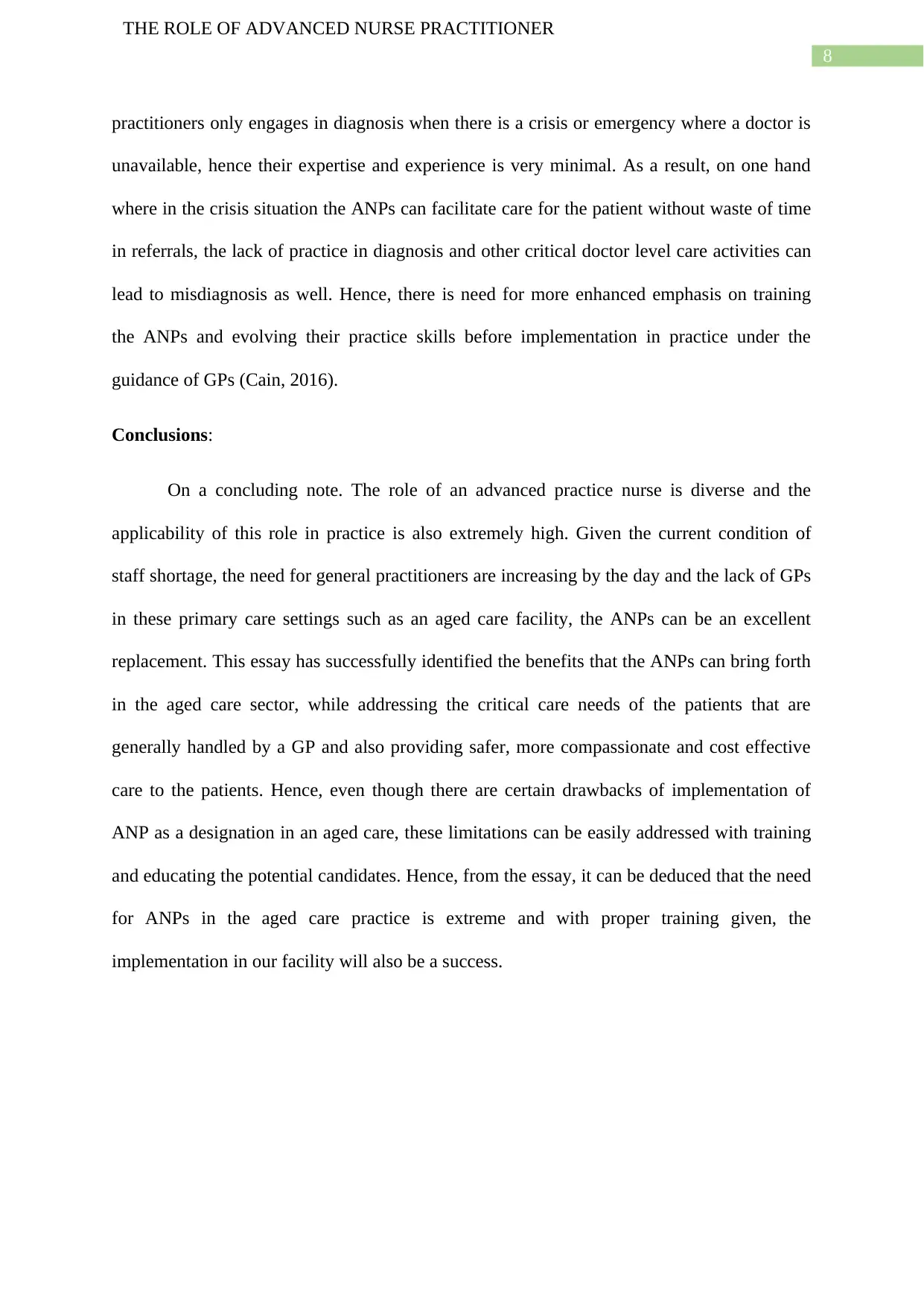
8
THE ROLE OF ADVANCED NURSE PRACTITIONER
practitioners only engages in diagnosis when there is a crisis or emergency where a doctor is
unavailable, hence their expertise and experience is very minimal. As a result, on one hand
where in the crisis situation the ANPs can facilitate care for the patient without waste of time
in referrals, the lack of practice in diagnosis and other critical doctor level care activities can
lead to misdiagnosis as well. Hence, there is need for more enhanced emphasis on training
the ANPs and evolving their practice skills before implementation in practice under the
guidance of GPs (Cain, 2016).
Conclusions:
On a concluding note. The role of an advanced practice nurse is diverse and the
applicability of this role in practice is also extremely high. Given the current condition of
staff shortage, the need for general practitioners are increasing by the day and the lack of GPs
in these primary care settings such as an aged care facility, the ANPs can be an excellent
replacement. This essay has successfully identified the benefits that the ANPs can bring forth
in the aged care sector, while addressing the critical care needs of the patients that are
generally handled by a GP and also providing safer, more compassionate and cost effective
care to the patients. Hence, even though there are certain drawbacks of implementation of
ANP as a designation in an aged care, these limitations can be easily addressed with training
and educating the potential candidates. Hence, from the essay, it can be deduced that the need
for ANPs in the aged care practice is extreme and with proper training given, the
implementation in our facility will also be a success.
THE ROLE OF ADVANCED NURSE PRACTITIONER
practitioners only engages in diagnosis when there is a crisis or emergency where a doctor is
unavailable, hence their expertise and experience is very minimal. As a result, on one hand
where in the crisis situation the ANPs can facilitate care for the patient without waste of time
in referrals, the lack of practice in diagnosis and other critical doctor level care activities can
lead to misdiagnosis as well. Hence, there is need for more enhanced emphasis on training
the ANPs and evolving their practice skills before implementation in practice under the
guidance of GPs (Cain, 2016).
Conclusions:
On a concluding note. The role of an advanced practice nurse is diverse and the
applicability of this role in practice is also extremely high. Given the current condition of
staff shortage, the need for general practitioners are increasing by the day and the lack of GPs
in these primary care settings such as an aged care facility, the ANPs can be an excellent
replacement. This essay has successfully identified the benefits that the ANPs can bring forth
in the aged care sector, while addressing the critical care needs of the patients that are
generally handled by a GP and also providing safer, more compassionate and cost effective
care to the patients. Hence, even though there are certain drawbacks of implementation of
ANP as a designation in an aged care, these limitations can be easily addressed with training
and educating the potential candidates. Hence, from the essay, it can be deduced that the need
for ANPs in the aged care practice is extreme and with proper training given, the
implementation in our facility will also be a success.
⊘ This is a preview!⊘
Do you want full access?
Subscribe today to unlock all pages.

Trusted by 1+ million students worldwide
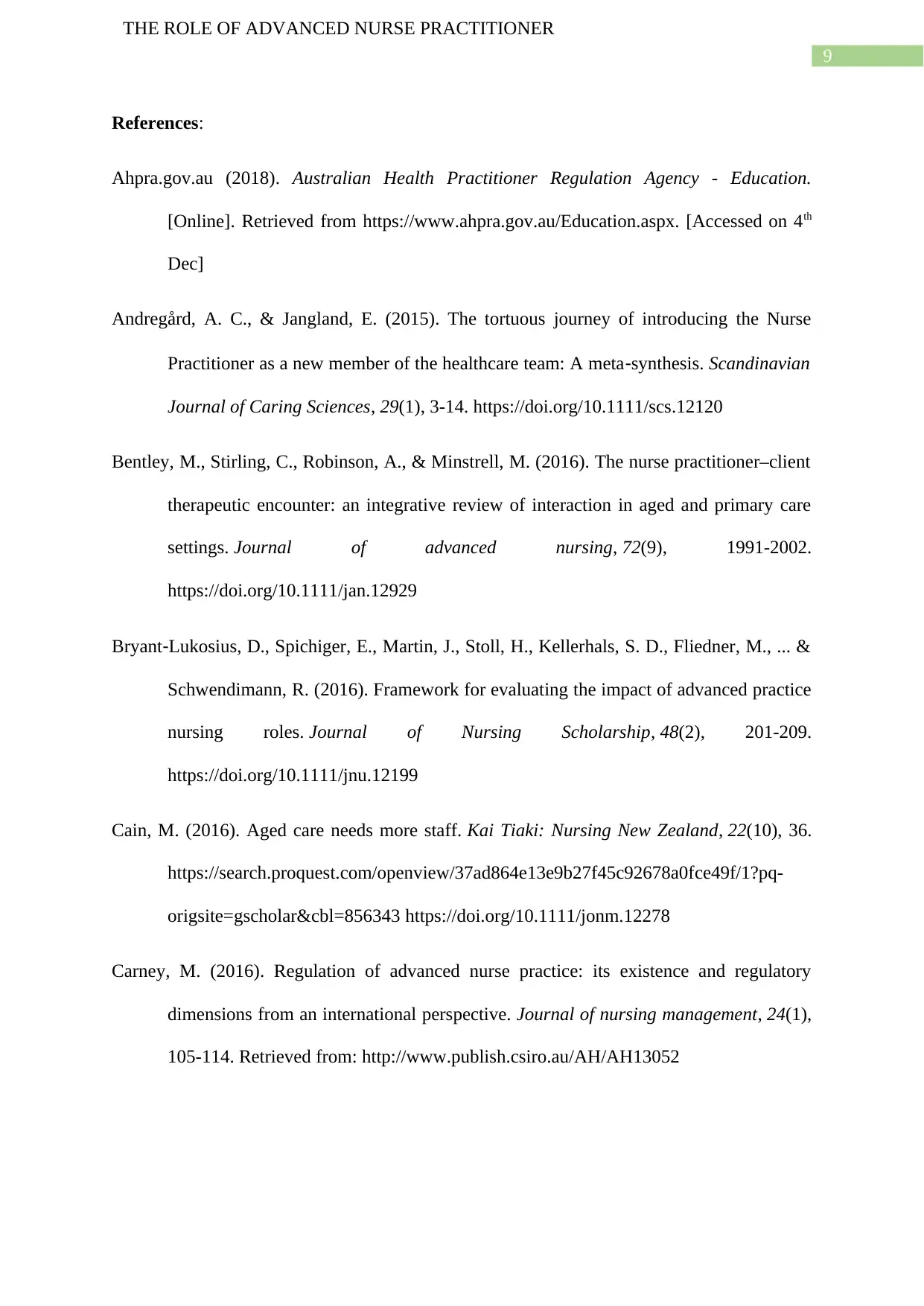
9
THE ROLE OF ADVANCED NURSE PRACTITIONER
References:
Ahpra.gov.au (2018). Australian Health Practitioner Regulation Agency - Education.
[Online]. Retrieved from https://www.ahpra.gov.au/Education.aspx. [Accessed on 4th
Dec]
Andregård, A. C., & Jangland, E. (2015). The tortuous journey of introducing the Nurse
Practitioner as a new member of the healthcare team: A meta‐synthesis. Scandinavian
Journal of Caring Sciences, 29(1), 3-14. https://doi.org/10.1111/scs.12120
Bentley, M., Stirling, C., Robinson, A., & Minstrell, M. (2016). The nurse practitioner–client
therapeutic encounter: an integrative review of interaction in aged and primary care
settings. Journal of advanced nursing, 72(9), 1991-2002.
https://doi.org/10.1111/jan.12929
Bryant‐Lukosius, D., Spichiger, E., Martin, J., Stoll, H., Kellerhals, S. D., Fliedner, M., ... &
Schwendimann, R. (2016). Framework for evaluating the impact of advanced practice
nursing roles. Journal of Nursing Scholarship, 48(2), 201-209.
https://doi.org/10.1111/jnu.12199
Cain, M. (2016). Aged care needs more staff. Kai Tiaki: Nursing New Zealand, 22(10), 36.
https://search.proquest.com/openview/37ad864e13e9b27f45c92678a0fce49f/1?pq-
origsite=gscholar&cbl=856343 https://doi.org/10.1111/jonm.12278
Carney, M. (2016). Regulation of advanced nurse practice: its existence and regulatory
dimensions from an international perspective. Journal of nursing management, 24(1),
105-114. Retrieved from: http://www.publish.csiro.au/AH/AH13052
THE ROLE OF ADVANCED NURSE PRACTITIONER
References:
Ahpra.gov.au (2018). Australian Health Practitioner Regulation Agency - Education.
[Online]. Retrieved from https://www.ahpra.gov.au/Education.aspx. [Accessed on 4th
Dec]
Andregård, A. C., & Jangland, E. (2015). The tortuous journey of introducing the Nurse
Practitioner as a new member of the healthcare team: A meta‐synthesis. Scandinavian
Journal of Caring Sciences, 29(1), 3-14. https://doi.org/10.1111/scs.12120
Bentley, M., Stirling, C., Robinson, A., & Minstrell, M. (2016). The nurse practitioner–client
therapeutic encounter: an integrative review of interaction in aged and primary care
settings. Journal of advanced nursing, 72(9), 1991-2002.
https://doi.org/10.1111/jan.12929
Bryant‐Lukosius, D., Spichiger, E., Martin, J., Stoll, H., Kellerhals, S. D., Fliedner, M., ... &
Schwendimann, R. (2016). Framework for evaluating the impact of advanced practice
nursing roles. Journal of Nursing Scholarship, 48(2), 201-209.
https://doi.org/10.1111/jnu.12199
Cain, M. (2016). Aged care needs more staff. Kai Tiaki: Nursing New Zealand, 22(10), 36.
https://search.proquest.com/openview/37ad864e13e9b27f45c92678a0fce49f/1?pq-
origsite=gscholar&cbl=856343 https://doi.org/10.1111/jonm.12278
Carney, M. (2016). Regulation of advanced nurse practice: its existence and regulatory
dimensions from an international perspective. Journal of nursing management, 24(1),
105-114. Retrieved from: http://www.publish.csiro.au/AH/AH13052
Paraphrase This Document
Need a fresh take? Get an instant paraphrase of this document with our AI Paraphraser
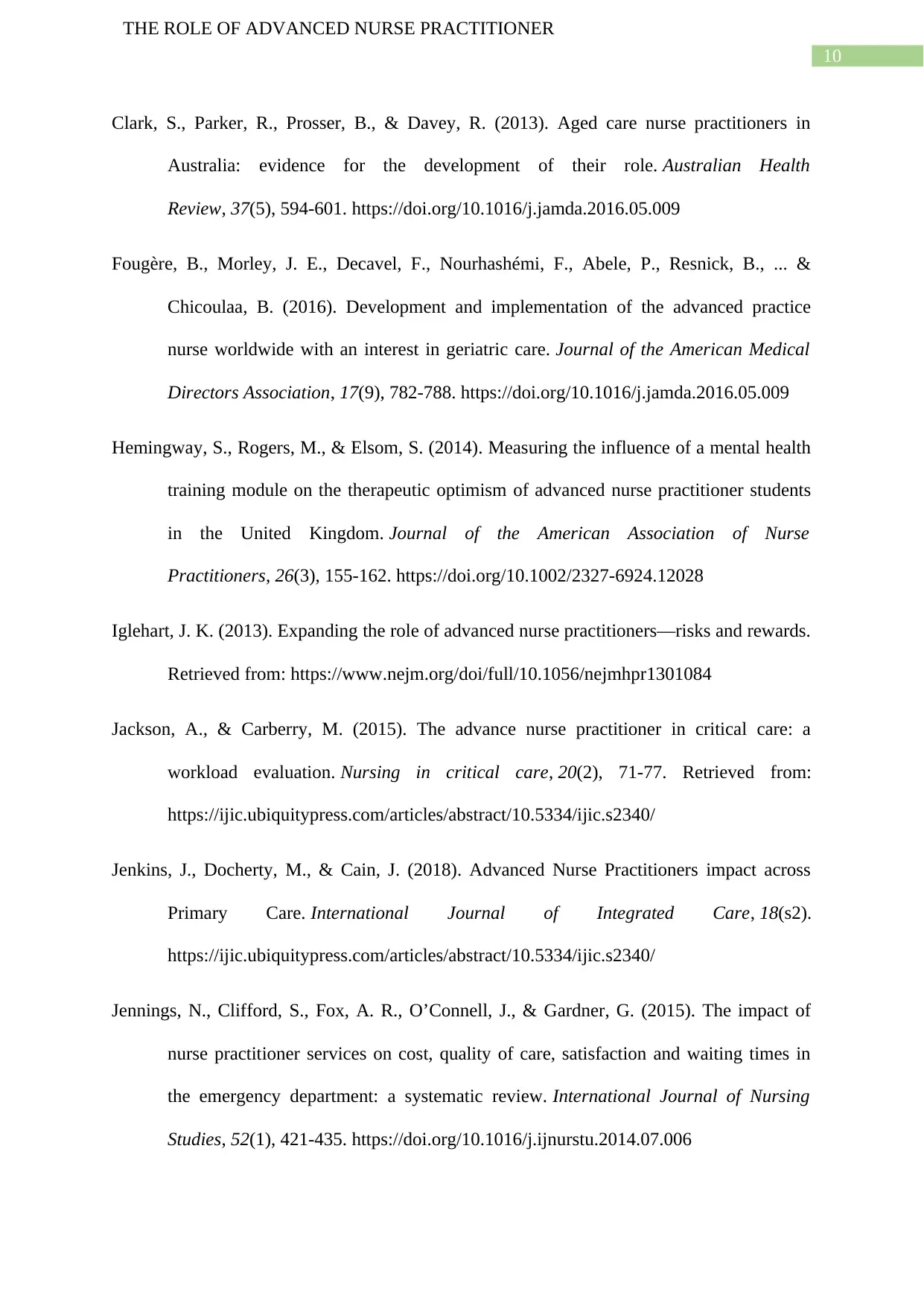
10
THE ROLE OF ADVANCED NURSE PRACTITIONER
Clark, S., Parker, R., Prosser, B., & Davey, R. (2013). Aged care nurse practitioners in
Australia: evidence for the development of their role. Australian Health
Review, 37(5), 594-601. https://doi.org/10.1016/j.jamda.2016.05.009
Fougère, B., Morley, J. E., Decavel, F., Nourhashémi, F., Abele, P., Resnick, B., ... &
Chicoulaa, B. (2016). Development and implementation of the advanced practice
nurse worldwide with an interest in geriatric care. Journal of the American Medical
Directors Association, 17(9), 782-788. https://doi.org/10.1016/j.jamda.2016.05.009
Hemingway, S., Rogers, M., & Elsom, S. (2014). Measuring the influence of a mental health
training module on the therapeutic optimism of advanced nurse practitioner students
in the United Kingdom. Journal of the American Association of Nurse
Practitioners, 26(3), 155-162. https://doi.org/10.1002/2327-6924.12028
Iglehart, J. K. (2013). Expanding the role of advanced nurse practitioners—risks and rewards.
Retrieved from: https://www.nejm.org/doi/full/10.1056/nejmhpr1301084
Jackson, A., & Carberry, M. (2015). The advance nurse practitioner in critical care: a
workload evaluation. Nursing in critical care, 20(2), 71-77. Retrieved from:
https://ijic.ubiquitypress.com/articles/abstract/10.5334/ijic.s2340/
Jenkins, J., Docherty, M., & Cain, J. (2018). Advanced Nurse Practitioners impact across
Primary Care. International Journal of Integrated Care, 18(s2).
https://ijic.ubiquitypress.com/articles/abstract/10.5334/ijic.s2340/
Jennings, N., Clifford, S., Fox, A. R., O’Connell, J., & Gardner, G. (2015). The impact of
nurse practitioner services on cost, quality of care, satisfaction and waiting times in
the emergency department: a systematic review. International Journal of Nursing
Studies, 52(1), 421-435. https://doi.org/10.1016/j.ijnurstu.2014.07.006
THE ROLE OF ADVANCED NURSE PRACTITIONER
Clark, S., Parker, R., Prosser, B., & Davey, R. (2013). Aged care nurse practitioners in
Australia: evidence for the development of their role. Australian Health
Review, 37(5), 594-601. https://doi.org/10.1016/j.jamda.2016.05.009
Fougère, B., Morley, J. E., Decavel, F., Nourhashémi, F., Abele, P., Resnick, B., ... &
Chicoulaa, B. (2016). Development and implementation of the advanced practice
nurse worldwide with an interest in geriatric care. Journal of the American Medical
Directors Association, 17(9), 782-788. https://doi.org/10.1016/j.jamda.2016.05.009
Hemingway, S., Rogers, M., & Elsom, S. (2014). Measuring the influence of a mental health
training module on the therapeutic optimism of advanced nurse practitioner students
in the United Kingdom. Journal of the American Association of Nurse
Practitioners, 26(3), 155-162. https://doi.org/10.1002/2327-6924.12028
Iglehart, J. K. (2013). Expanding the role of advanced nurse practitioners—risks and rewards.
Retrieved from: https://www.nejm.org/doi/full/10.1056/nejmhpr1301084
Jackson, A., & Carberry, M. (2015). The advance nurse practitioner in critical care: a
workload evaluation. Nursing in critical care, 20(2), 71-77. Retrieved from:
https://ijic.ubiquitypress.com/articles/abstract/10.5334/ijic.s2340/
Jenkins, J., Docherty, M., & Cain, J. (2018). Advanced Nurse Practitioners impact across
Primary Care. International Journal of Integrated Care, 18(s2).
https://ijic.ubiquitypress.com/articles/abstract/10.5334/ijic.s2340/
Jennings, N., Clifford, S., Fox, A. R., O’Connell, J., & Gardner, G. (2015). The impact of
nurse practitioner services on cost, quality of care, satisfaction and waiting times in
the emergency department: a systematic review. International Journal of Nursing
Studies, 52(1), 421-435. https://doi.org/10.1016/j.ijnurstu.2014.07.006
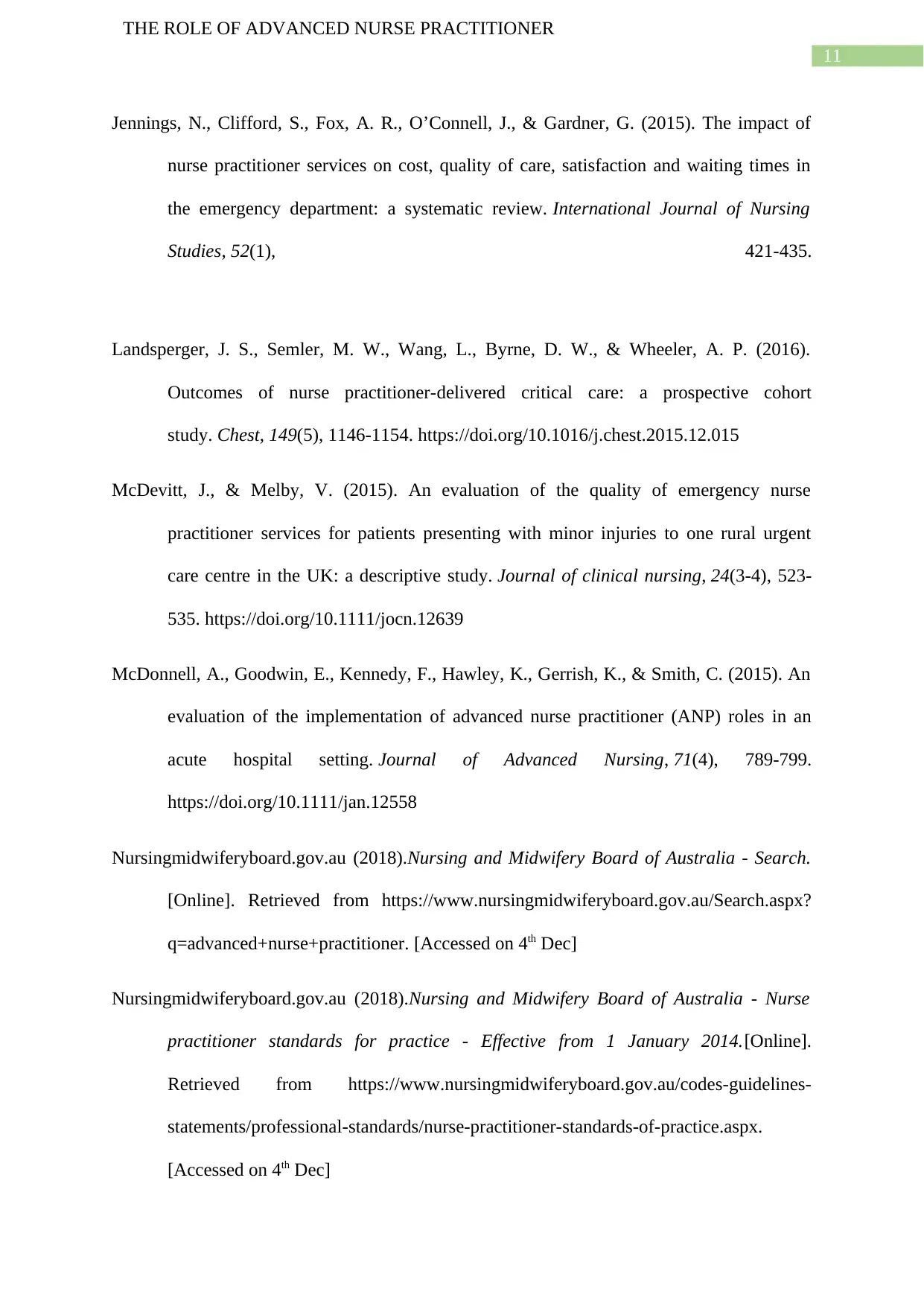
11
THE ROLE OF ADVANCED NURSE PRACTITIONER
Jennings, N., Clifford, S., Fox, A. R., O’Connell, J., & Gardner, G. (2015). The impact of
nurse practitioner services on cost, quality of care, satisfaction and waiting times in
the emergency department: a systematic review. International Journal of Nursing
Studies, 52(1), 421-435.
Landsperger, J. S., Semler, M. W., Wang, L., Byrne, D. W., & Wheeler, A. P. (2016).
Outcomes of nurse practitioner-delivered critical care: a prospective cohort
study. Chest, 149(5), 1146-1154. https://doi.org/10.1016/j.chest.2015.12.015
McDevitt, J., & Melby, V. (2015). An evaluation of the quality of emergency nurse
practitioner services for patients presenting with minor injuries to one rural urgent
care centre in the UK: a descriptive study. Journal of clinical nursing, 24(3-4), 523-
535. https://doi.org/10.1111/jocn.12639
McDonnell, A., Goodwin, E., Kennedy, F., Hawley, K., Gerrish, K., & Smith, C. (2015). An
evaluation of the implementation of advanced nurse practitioner (ANP) roles in an
acute hospital setting. Journal of Advanced Nursing, 71(4), 789-799.
https://doi.org/10.1111/jan.12558
Nursingmidwiferyboard.gov.au (2018).Nursing and Midwifery Board of Australia - Search.
[Online]. Retrieved from https://www.nursingmidwiferyboard.gov.au/Search.aspx?
q=advanced+nurse+practitioner. [Accessed on 4th Dec]
Nursingmidwiferyboard.gov.au (2018).Nursing and Midwifery Board of Australia - Nurse
practitioner standards for practice - Effective from 1 January 2014.[Online].
Retrieved from https://www.nursingmidwiferyboard.gov.au/codes-guidelines-
statements/professional-standards/nurse-practitioner-standards-of-practice.aspx.
[Accessed on 4th Dec]
THE ROLE OF ADVANCED NURSE PRACTITIONER
Jennings, N., Clifford, S., Fox, A. R., O’Connell, J., & Gardner, G. (2015). The impact of
nurse practitioner services on cost, quality of care, satisfaction and waiting times in
the emergency department: a systematic review. International Journal of Nursing
Studies, 52(1), 421-435.
Landsperger, J. S., Semler, M. W., Wang, L., Byrne, D. W., & Wheeler, A. P. (2016).
Outcomes of nurse practitioner-delivered critical care: a prospective cohort
study. Chest, 149(5), 1146-1154. https://doi.org/10.1016/j.chest.2015.12.015
McDevitt, J., & Melby, V. (2015). An evaluation of the quality of emergency nurse
practitioner services for patients presenting with minor injuries to one rural urgent
care centre in the UK: a descriptive study. Journal of clinical nursing, 24(3-4), 523-
535. https://doi.org/10.1111/jocn.12639
McDonnell, A., Goodwin, E., Kennedy, F., Hawley, K., Gerrish, K., & Smith, C. (2015). An
evaluation of the implementation of advanced nurse practitioner (ANP) roles in an
acute hospital setting. Journal of Advanced Nursing, 71(4), 789-799.
https://doi.org/10.1111/jan.12558
Nursingmidwiferyboard.gov.au (2018).Nursing and Midwifery Board of Australia - Search.
[Online]. Retrieved from https://www.nursingmidwiferyboard.gov.au/Search.aspx?
q=advanced+nurse+practitioner. [Accessed on 4th Dec]
Nursingmidwiferyboard.gov.au (2018).Nursing and Midwifery Board of Australia - Nurse
practitioner standards for practice - Effective from 1 January 2014.[Online].
Retrieved from https://www.nursingmidwiferyboard.gov.au/codes-guidelines-
statements/professional-standards/nurse-practitioner-standards-of-practice.aspx.
[Accessed on 4th Dec]
⊘ This is a preview!⊘
Do you want full access?
Subscribe today to unlock all pages.

Trusted by 1+ million students worldwide
1 out of 13
Related Documents
Your All-in-One AI-Powered Toolkit for Academic Success.
+13062052269
info@desklib.com
Available 24*7 on WhatsApp / Email
![[object Object]](/_next/static/media/star-bottom.7253800d.svg)
Unlock your academic potential
Copyright © 2020–2025 A2Z Services. All Rights Reserved. Developed and managed by ZUCOL.





